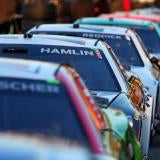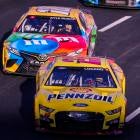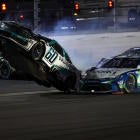
When NASCAR racing began in 1949, what is now known as the Cup Series was referred to as the "Strictly Stock" division -- stock cars ready to race right off the showroom floor. A lot has changed since then, and the cars used at NASCAR's highest level have gone from strictly stock car to strictly race car. But with their seventh-generation Cup car, NASCAR is both making a major leap back towards the days when stock cars were stock and forward into new possibilities as to what they can be.
The 2022 season marks the first for NASCAR's new Next Gen car, which replaces the Gen 6 used from 2013 to 2021 as the car and chassis raced in the Cup Series. The Next Gen platform, which has been developed over the past several years as well as an extensive schedule of winter testing, gives NASCAR's three automakers a car that is more faithful and relevant to their street equivalents, while also giving NASCAR a machine that can both enhance the level of on-track competition and allow for more cutting-edge and relevant technology.
The Next Gen car made its debut in competition at the Busch Light Clash at the Los Angeles Coliseum, where it was put through its paces around the Coliseum's tight and demanding quarter-mile track. Here is an overview of the Next Gen car as it gets set to make its first official start in a points-paying race.
How does the Next Gen car look?
While the exact characteristics of the Next Gen car all vary slightly by make -- the Chevrolet Camaro ZL1, the Ford Mustang, and the Toyota TRD Camry -- the overall common aesthetic is that of a sleeker and more coupe look. The car features a shorter greenhouse, shortened deck lid, and widened track width, as well as 18" forged aluminum wheels and wider tires. The wheels will also feature a single lug-nut design, as opposed to the traditional five lug-nut design of previous generations.
The body of the Next Gen car is fully symmetrical, which will reduce aerodynamic forces on the car and put the emphasis back on car setup and driver skill. Rather than sheet metal, the body of the Next Gen car is a composite material that is more durable and can greater withstand contact with the wall or other cars without loss of performance.
What are the Next Gen car's components?
The Next Gen car features upgraded specs to match modern passenger vehicle technology, including an independent rear suspension, rack and pinion steering, and larger brakes. The transmission and rear gear of the car has been combined into one package through a new transaxle, which will also help allow for the ability to incorporate electrification into the car in the future.
The car also allows for an in-car camera in every vehicle, and overall upgraded car connectivity will allow for more real-time data to be transmitted to fans.
The redesigned chassis of the car features new front and rear bumpers, which allow for increased safety. In addition, the front and rear clips of the car bolt onto the center section, which will allow for easier serviceability and damage repair. This was seen during a test of the car at Charlotte Motor Speedway, as Richard Childress Racing was able to repair a car crashed by Austin Dillon and have it back on-track the very same day.
The Next Gen car also features several components that aim to reduce aerodynamic forces and the impact of "dirty air" -- or turbulent air trailing from a car that impedes the handling and progress of cars running behind it. The bottom of the car is sealed with an underwing and rear diffuser, while louvers in the hood of the car allow for engine performance to be maximized independent of aerodynamics. In theory, this should allow for better handling and raceability in traffic.
How is the Next Gen car built?
With NASCAR seeking to implement a new business model to make stock car racing more affordable and accessible, the Next Gen car represents a major shift in how NASCAR Cup Series cars are assembled and maintained. Rather than manufacturing parts and pieces themselves, NASCAR teams will now purchase parts for the Next Gen car from single sources such as Five Star Race Car Bodies, Dallara, McLaren, and others.
Team inventory of cars is now also being much more regulated by NASCAR in the interest of controlling costs and increasing parity. Race teams will now be limited to seven cars per car number at a given time, with NASCAR and the chassis supplier making the determination of whether a chassis can be repaired or must be replaced in the event of a crash. Teams will not be allowed to replace a car until it is used in at least three races.
How much horsepower and downforce does the car have?
After several years of hotly-contested debate over which direction NASCAR should take, the Next Gen car will feature a high-horsepower and low-downforce aerodynamic package that has proven popular among fans and competitors. The Next Gen car will have an engine output of 670 horsepower at most racetracks, with a four-inch spoiler on the rear decklid. While NASCAR had experimented with lower horsepower in recent years as a means of potentially attracting new OEMs into the sport to join Chevrolet, Ford, and Toyota, NASCAR Chief Racing Development Officer Steve O'Donnell stated in December that 670 horsepower was "within the range" to attract another automaker to the sport.
A different package will be used at the superspeedways of Daytona International Speedway and Talladega Superspeedway as well as the newly-reconfigured Atlanta Motor Speedway, as NASCAR will utilize 510 horsepower and a seven-inch rear spoiler in the interests of keeping speeds from rising too high while also offering a compelling superspeedway racing product.
Is the Next Gen car safe?
In the development of the Next Gen car, there was some talk of whether or not the car was as safe as the previous two generations of Cup Series car. This was highlighted by a rumor that spread in the Summer of 2021 stemming from a Next Gen crash test conducted at Talladega Superspeedway. As recounted in an Autoweek story, NASCAR had held a crash test on June 23 with a car driven by a robot and fitted with a crash-test dummy, but the sled failed and prevented NASCAR from sending the car into the wall.
The "failure" of the crash test soon took a life of its own, as a rumor began to spread that the crash test dummy had been "killed" and that the Next Gen car was too rigid and had too few crush zones to dissipate the force of an impact away from the driver. NASCAR emphatically denied that such had occurred, sharing that dummy data from its test showed "good and comparable performance when compared to other right frontal dummy data" from non-Next Gen crashes.
In a November 2021 test at Charlotte Motor Speedway, NASCAR stated that the Next Gen car "performed as designed" in a head-on crash by Austin Dillon, which registered as an above-average impact per NASCAR data. Dillon was uninjured and returned to the track later in the day.
NASCAR's outstanding track record on car and driver safety over the last 20 years far precedes the introduction of the Next Gen car. A driver has not been killed in one of NASCAR's top three national series since 2001..
Why is the number so far forward?
One of the most instantly-noticeable elements of Next Gen cars is that the car number has been moved forward from the center of the door more towards the front wheel well. This is a move that was pushed for by race teams, as it gives sponsors a larger portion of the car's side and theoretically increases value for sponsors according to a study ordered by Nielsen. Part of this was out of necessity, as the smaller quarter panels of the Next Gen car impacted the available space for sponsorship.
"We all know how important the number is to a fan's connection with their driver. Moving the numbers forward should make them more visible, and will also provide the race teams an opportunity to give sponsors some enhanced branding opportunities," Torrey Galida, president of Richard Childress Racing, said last August.
While the placement of the Next Gen number may seem jarring at first glance, it isn't totally unheard of. In the 1970s and 1980s, for instance, similar designs were used by cars in NASCAR's Late Model Sportsman Series.
![[object Object] Logo](https://sportshub.cbsistatic.com/i/2020/04/22/e9ceb731-8b3f-4c60-98fe-090ab66a2997/screen-shot-2020-04-22-at-11-04-56-am.png)


















